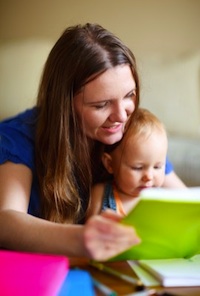You may or may not be aware that promoting a love of reading and good reading habits begins right from birth. Children love to hear language and being to imitate these sounds early on.
From the very beginning, babies try to imitate the sounds that they hear us make. They “read” the looks on our faces and our movements. That’s why it is so important to talk, sing, smile, and gesture to your baby. Hearing you talk is your baby’s very first step toward becoming a reader, because it helps him or her to love language and to learn words.
As your child grows older, continue talking with him or her. Ask her about the things they do, about the events and people in the stories you read together. Let baby know you are listening carefully to what he or she says when they babble and goo at you. By engaging them in talking and listening, you’re also encouraging your child to think as she speaks.
Reading books aloud to child stimulates their imagination and develops their understanding of the world. It helps a child to develop language and listening skills and prepares them to understand the written word.
Start them Young
At just a few months of age, your baby can look at pictures, listen to your voice, and point to objects on cardboard pages. Even at this early age you can be guiding them by
- pointing to the pictures, and say the names of the various objects,
- counting objects on the pages,
- stating the colour names,
- drawing attention to pictures and associating the words with both pictures and the real-world objects.
If you can do all these things your baby will begin to learn the importance of language and before you know it will be mimicking these things.
Reading Together
All the talking and interacting with your baby as you read shows them that there is a connection to be made between words and pictures. This is an extremely important connection and one that leads to them wanting to begin scribbling, drawing and ‘writing’.
While you child is still a baby, reading aloud should become a part of your daily routine.
At first read for short burst to get your little one used to it but read several times a day. Chances are once your little one realises this is an enjoyable activity he or she will egging you on with books all the time.
As your baby grows older you’ll be able to tell if he or she wants you to read for longer periods. You should work up to a half hour reading stint. Don’t be upset if there’s a day where the reading doesn’t fit or if your little one isn’t interested. Make sure you do get back to the routine asap.
- Pick a quiet time that is good for you both, like the half an hour before you put baby to bed.
- Read cosyed and cuddled up together, lying down or with baby on your lap.
- Stop if baby gets tired and is struggling to stay put or interested – reading should be enjoyable and if baby is trying to ‘escape’ then it’s “not happening”!
Reading is Physical
Reading is as much a physical act as it is a mental one. Children need to learn how to hold a book, turn pages, read from left to right, all of which requires involves hand-eye coordination. For all those hours you spend reading to your little one remember this and work on involving him or her by
- having them hold one side of the book,
- pointing out objects in the pictures;
- following the words with your finger (so your child develops a sense that the words go from left to fight on the page); and
- having your child help turn the pages (to learn that the pages turn from right to left).
Reading, reading and more reading is the best way to help your little one become a reader. But remember the number one rule for both or you is “KEEP IT FUN!” Don’t let it become another chore or boring activity.





